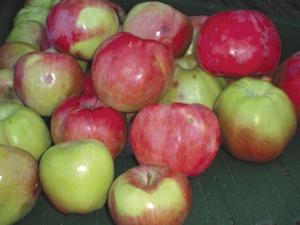Northern Spy apples make the best pie
Around 1830, a full 22 years before publication of “Uncle Tom’s Cabin,” an anonymous author published a book that some say also led to the Civil War. The gripping tale was of a double agent who pretended to be a slave catcher only to help slaves escape on the underground railroad to the north and freedom. The book became a hit among abolitionists, and soon everyone was talking about the notorious novel, “The Northern Spy.”
Years before this novel took the country by storm, around 1800, Herman Chapin planted apple seeds on his farm in East Bloomfield, N.Y. The best tree was killed before it even bloomed, and that might have been the end of it, except that Chapin’s brother-in-law, Roswell Humphrey, brought the sprouting roots to his nearby farm, and eventually it grew and bloomed.
Because seedling apple trees often take up to 10 years to bloom and set fruit, this orphaned tree probably didn’t come into full production until around 1825. The tree, like the novel, was called “The Northern Spy.”
This Northern Spy apple’s pure white blossoms bloomed well after most killing frosts in late spring, so it was a dependable bearing tree even when nearby apple trees were hurt by frosts. These apples are green-skinned, but heavily streaked with a pinkish red, with prominent ribs and broad shoulders. The bottom of the apple rests on five prominent knobs much like a Red Delicious. Northern Spy has unforgettable, delicious crisp white flesh that is at once honey sweet and mouth-puckering tart. These beautiful apples are very high in vitamin C. Combined with its huge size and excellent storage ability, it is still popular not only throughout its native Finger Lakes region, but one of the top apples grown to this day.
This all-purpose variety is great to eat fresh out of hand, cooked into apple butter, made into applesauce, sliced in salads and a favorite for cider. But it really comes into its own as one of the best apples for pies, especially if picked in late September, a little early in its usual harvest season of October.
The Northern Spy tree is large, upright with shiny medium-sized leaves. Luckily it is readily available grafted onto dwarfing rootstock, which besides shrinking the tree to a manageable height gets it to fruit in just a few years. Trees are widely available from local nurseries or by mail from companies such as Fedco (www.fedcoseeds.com, PO Box 520, Waterville, ME 04903, Phone: 207-426-9900), Trees of Antiquity (www.treesofantiquity.com, 20 Wellsona Road, Paso Robles, CA 93446 Phone: 805-467-9909), or Stark Brothers (www.starkbros.com, P.O. Box 1800, Louisiana, MO 63353, Phone: 800-325-4180).
Fall is the best time to plant trees because they can establish roots over the winter. Plant Northern Spy apples in well- drained soil, preferably with a pH of 6.0-7.0. These hardy trees will grow well in USDA zones 4-9. It will need another apple tree nearby that blooms late for pollination. The best pollinators include Newtown Pippin, Ginger Gold, Red Delicious, or Golden Delicious.
Slavery is long gone, but this 200-year-old apple still remains popular. Plant a Northern Spy this year and you will have big, delicious orbs for snacking, for applesauce, cider and apple butter, and best of all for apple pie. Because as an old jingle goes, “If it isn’t made from Northern Spy, it’s not a pie.”
























































